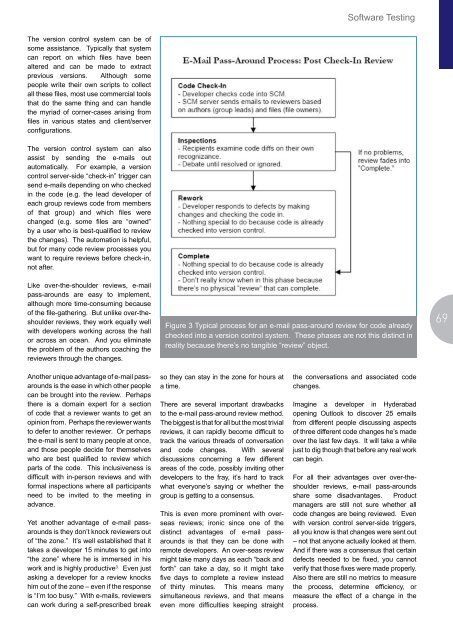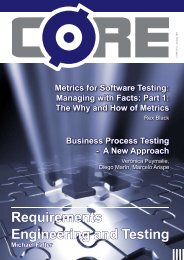Comparison of Change Management Systems
Comparison of Change Management Systems
Comparison of Change Management Systems
Create successful ePaper yourself
Turn your PDF publications into a flip-book with our unique Google optimized e-Paper software.
The version control system can be <strong>of</strong><br />
some assistance. Typically that system<br />
can report on which files have been<br />
altered and can be made to extract<br />
previous versions. Although some<br />
people write their own scripts to collect<br />
all these files, most use commercial tools<br />
that do the same thing and can handle<br />
the myriad <strong>of</strong> corner-cases arising from<br />
files in various states and client/server<br />
configurations.<br />
The version control system can also<br />
assist by sending the e-mails out<br />
automatically. For example, a version<br />
control server-side “check-in” trigger can<br />
send e-mails depending on who checked<br />
in the code (e.g. the lead developer <strong>of</strong><br />
each group reviews code from members<br />
<strong>of</strong> that group) and which files were<br />
changed (e.g. some files are “owned”<br />
by a user who is best-qualified to review<br />
the changes). The automation is helpful,<br />
but for many code review processes you<br />
want to require reviews before check-in,<br />
not after.<br />
Like over-the-shoulder reviews, e-mail<br />
pass-arounds are easy to implement,<br />
although more time-consuming because<br />
<strong>of</strong> the file-gathering. But unlike over-theshoulder<br />
reviews, they work equally well<br />
with developers working across the hall<br />
or across an ocean. And you eliminate<br />
the problem <strong>of</strong> the authors coaching the<br />
reviewers through the changes.<br />
Another unique advantage <strong>of</strong> e-mail passarounds<br />
is the ease in which other people<br />
can be brought into the review. Perhaps<br />
there is a domain expert for a section<br />
<strong>of</strong> code that a reviewer wants to get an<br />
opinion from. Perhaps the reviewer wants<br />
to defer to another reviewer. Or perhaps<br />
the e-mail is sent to many people at once,<br />
and those people decide for themselves<br />
who are best qualified to review which<br />
parts <strong>of</strong> the code. This inclusiveness is<br />
difficult with in-person reviews and with<br />
formal inspections where all participants<br />
need to be invited to the meeting in<br />
advance.<br />
Yet another advantage <strong>of</strong> e-mail passarounds<br />
is they don’t knock reviewers out<br />
<strong>of</strong> “the zone.” It’s well established that it<br />
takes a developer 15 minutes to get into<br />
“the zone” where he is immersed in his<br />
work and is highly productive 3. Even just<br />
asking a developer for a review knocks<br />
him out <strong>of</strong> the zone – even if the response<br />
is “I’m too busy.” With e-mails, reviewers<br />
can work during a self-prescribed break<br />
S<strong>of</strong>tware Testing<br />
Figure 3 Typical process for an e-mail pass-around review for code already<br />
checked into a version control system. These phases are not this distinct in<br />
reality because there’s no tangible “review” object.<br />
so they can stay in the zone for hours at<br />
a time.<br />
There are several important drawbacks<br />
to the e-mail pass-around review method.<br />
The biggest is that for all but the most trivial<br />
reviews, it can rapidly become difficult to<br />
track the various threads <strong>of</strong> conversation<br />
and code changes. With several<br />
discussions concerning a few different<br />
areas <strong>of</strong> the code, possibly inviting other<br />
developers to the fray, it’s hard to track<br />
what everyone’s saying or whether the<br />
group is getting to a consensus.<br />
This is even more prominent with overseas<br />
reviews; ironic since one <strong>of</strong> the<br />
distinct advantages <strong>of</strong> e-mail passarounds<br />
is that they can be done with<br />
remote developers. An over-seas review<br />
might take many days as each “back and<br />
forth” can take a day, so it might take<br />
five days to complete a review instead<br />
<strong>of</strong> thirty minutes. This means many<br />
simultaneous reviews, and that means<br />
even more difficulties keeping straight<br />
the conversations and associated code<br />
changes.<br />
Imagine a developer in Hyderabad<br />
opening Outlook to discover 25 emails<br />
from different people discussing aspects<br />
<strong>of</strong> three different code changes he’s made<br />
over the last few days. It will take a while<br />
just to dig though that before any real work<br />
can begin.<br />
For all their advantages over over-theshoulder<br />
reviews, e-mail pass-arounds<br />
share some disadvantages. Product<br />
managers are still not sure whether all<br />
code changes are being reviewed. Even<br />
with version control server-side triggers,<br />
all you know is that changes were sent out<br />
– not that anyone actually looked at them.<br />
And if there was a consensus that certain<br />
defects needed to be fixed, you cannot<br />
verify that those fixes were made properly.<br />
Also there are still no metrics to measure<br />
the process, determine efficiency, or<br />
measure the effect <strong>of</strong> a change in the<br />
process.<br />
69



